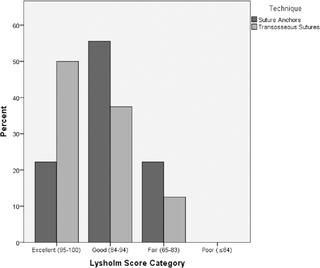PLOS ONE ( IF 2.9 ) Pub Date : 2018-03-19 , DOI: 10.1371/journal.pone.0194376 Stefan Plesser , Mohammad Keilani , Gyoergy Vekszler , Timothy Hasenoehrl , Stefano Palma , Martin Reschl , Richard Crevenna , Stefan Hajdu , Harald Kurt Widhalm

|
Biomechanical studies have shown the use of suture anchors (SA) to be superior to the traditional transosseous sutures (TS) in the repair of quadriceps tendon rupture (QTR). This study aimed to analyze and compare the functional outcomes of patients treated for quadriceps tendon ruptures using suture anchors or transosseous sutures. Patients having undergone suture anchor repair or transosseous suture repair for quadriceps tendon rupture between 2010 and 2015 at one of the two participating hospitals were included. Patients from site A underwent TS repair (TS group) while patients from site B underwent SA repair (SA group). Exclusion criteria included previous or concomitant injuries of the involved knee, penetrating injuries and pre-existing neurological conditions. Clinical outcome was assessed by subjective scores (Lysholm and Tegner Scores, International Knee Documentation Committee (IKDC) Score, Visual Analog Scale (VAS) for pain), quadriceps isokinetic strength testing, Insall-Salvati Index (ISI), and physical examination. Non-parametrical statistical analysis was conducted using the Mann-Whitney U test. Twenty-seven patients were included in the study of which 17 patients (63%) were available for follow-up (SA group: 9, TS group: 8). All patients were male with a mean age of 62.7 (SD: 8.8) and 57.9 (SD: 12.7) years for the SA group and TS group, respectively. The groups did not differ in terms of demographic characteristics. No clinically significant differences were identified between the two groups. There were no re-ruptures in either group. Treatment of quadriceps tendon rupture using suture anchors provides a clinically valid alternative treatment to the gold-standard transosseous suture repair.
中文翻译:

股四头肌腱断裂治疗后的临床结果显示相同的结果,而与所使用的缝合锚钉或经骨骨修复技术无关–一项初步研究
生物力学研究表明,在股四头肌腱断裂(QTR)的修复中,使用缝线锚(SA)优于传统的穿骨缝线(TS)。这项研究旨在分析和比较使用缝合锚钉或经骨骨缝合治疗股四头肌腱断裂的患者的功能结局。纳入2010年至2015年间在两家参与医院之一的四头肌腱断裂中进行了缝合锚钉修复或经骨骨缝合修复的患者。来自站点A的患者接受TS修复(TS组),而来自站点B的患者接受SA修复(SA组)。排除标准包括受累膝盖先前或同时发生的损伤,穿透性损伤和先前存在的神经系统疾病。通过主观评分(莱瑟姆(Lysholm)和泰格纳(Tegner)评分,国际膝关节文献委员会(IKDC)得分,视觉模拟量表(VAS)(用于疼痛),股四头肌等速肌力测试,萨索尔瓦蒂(Insall-Salvati Index)和身体检查。使用Mann-Whitney进行非参数统计分析U检验。本研究纳入了27位患者,其中17位患者(63%)可以进行随访(SA组:9,TS组:8)。SA组和TS组的所有患者均为男性,平均年龄分别为62.7(SD:8.8)和57.9(SD:12.7)岁。这些群体在人口统计学特征上没有差异。两组之间没有发现临床上的显着差异。两组均无再破裂。使用缝合锚钉治疗股四头肌腱断裂为金标准经皮骨缝合修复提供了临床有效的替代治疗。











































 京公网安备 11010802027423号
京公网安备 11010802027423号